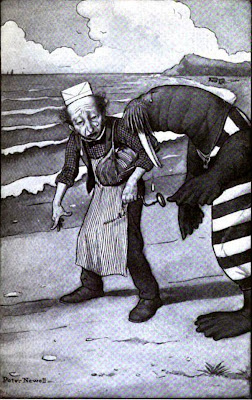 | Original image of temple garment circa 1879, taken from Salt Lake Tribune, September 28, 1879, page 4.
This media file is in the public domain because its copyright has expired. This applies to the United States, where Works published prior to 1978 were copyright protected for a maximum of 75 years. See Circular 1 "COPYRIGHT BASICS" from the U.S. Copyright Office. |
Works published before 1924 are now in the public domain and also in countries that figure copyright from the date of death of the artist (post mortem auctoris) and that most commonly run for a period of 50 to 70 years from December 31st of that year.
Mormon Temple Under Garment: The marks are a reverse-L-shaped symbol on the right breast, a V-shaped symbol on the left breast, and horizontal marks at the navel and over the right knee. These cuts were later replaced by embroidered symbols.
According to generally-accepted Mormon doctrine, the marks in the garments are sacred symbols. The V-shaped symbol on the left breast was referred to as "The Compasses", while the reverse-L-shaped symbol on the right breast was referred to by early church leaders as "The Square"
According to an explanation by LDS Church President John Taylor in 1883, the "Square" represents "the justice and fairness of our Heavenly Father, that we will receive all the good that is coming to us or all that we earn, on a square deal", and the "Compasses" represents "the North Star". In addition to the Square and Compasses, Taylor described the other symbols as follows: the collar represented the idea that the Lord's "yoke is easy and [his] burden is light", or the "Crown of the Priesthood"; the double-knotted strings represented "the Trinity" and "the marriage covenant"; the navel mark represents "strength in the navel and marrow in the bones"; and the knee mark represents "that every knee shall bow and every tongue confess that Jesus is the Christ".
The ceremony of Endowment: The under garment, which is alike for both sexes, is a sort of jacket anil trousers together, something like the night-dresses made for children; and is worn night and day. When changed, only an arm or a leg must be removed at once, the fresh garment being thus put on as the other is taken off. This garment protects from disease, and even death, for the bullet of an enemy will nut penetrate it. The prophet Joseph carelessly left off this garment on the day of his death, and had lie not done so, he would have escaped unharmed. Over the inner garment the men wear an ordinary shirt, and the women a white skirt. White stockings and a pair of vhite linen slippers complete the costume.
Entering the building, the candidate's own name and age are registered, and also the names of the parents. The candidates hand in their oil, remove their shoes, and pass with their bundles of clothing into a bath-room divided down the middle by a heavy curtain which separates the sexes. Here the ceremony of purification is performed, the women being washed by women, and the men by men. The person washed is informed that he or she is now cleansed from the blood of this generation, and if faithful, shall never be subject to the plagues and miseries which are about to come upon the earth.
Next follows tlie anointing. The oil is poured from a large horn into the hand of the person officiating, and applied to the crown of the head, eyes, ears, mouth, and feet of the candidate. The eyes are touched, that they may be quick to see; the ears, that the hearing may be sharp; the mouth, to bestow wisdom upon speech; and the feet, that they be swift to run in the ways of the Lord.
A new name, which is rarely to be mentioned, is whispered into the ear, and all are marched into room No. 2, where they are seated, the sexes on opposite sides of the room, and facing each other. Here they are told by a priest that any person not strong enough to proceed may retire; but if any portion of the ceremony is disclosed, the throat of the person so offending will be cut from car to ear. Those faltering, if any, having retired, the remainder are taken into room No. 3, where a representation of the creation, the temptation, and fall is given.
Each candidate then puts on over his robe an apron of white linen, upon which are sewn pieces of green silk representing fig-leaves, and also the cap or veil. All good Mormons are buried in their endowment robes, and the veil worn by the women covers their faces when they are consigned to the grave. In the morning of the resurrection, this veil in to be lifted by the husband; otherwise no woman can see the face of the almighty in the next world.
Sources
- Hand-book on Mormonism - Hand-book on Mormonism By John McCutchen Coyner Compiled by John McCutchen Coyner Published by Hand-book publishing co., 1882 Original from Ghent University Digitized Jan 28, 2008 95 pages
- The Works of Hubert Howe Bancroft - The Works of Hubert Howe Bancroft By Hubert Howe Bancroft, Alfred Bates, Henry Hortop, Robert Zelinsky, History Company, Barbara Zelinsky, John O. Haman, Henry Lebbeus Oak, A.L. Bancroft & Company, Henry Stiner Published by History Co., 1889 Item notes: v. 26 Original from the University of California Digitized Jun 12, 2007 808 pages
- Temple garment From Wikipedia, the free encyclopedia - All Wikipedia text is available under the terms of the GNU Free Documentation License.
























